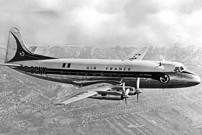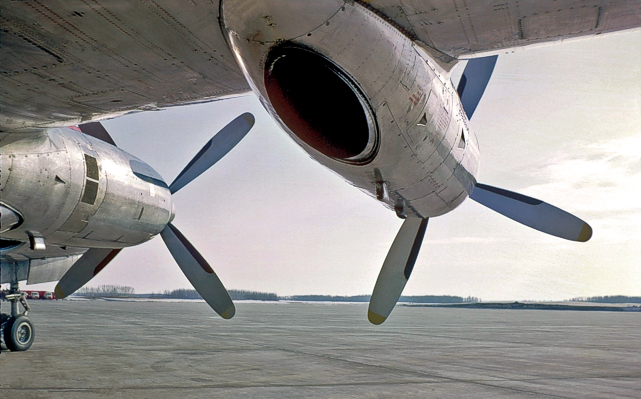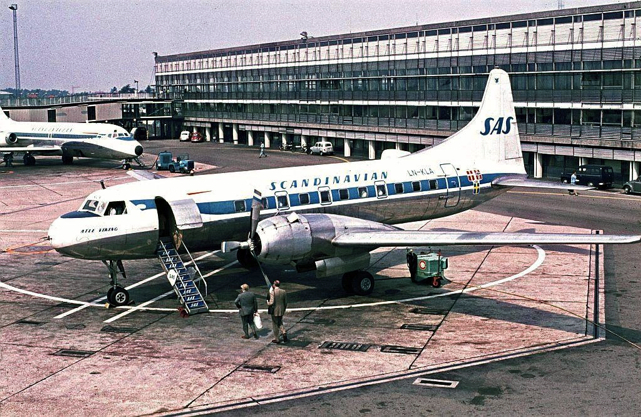TCA - Trans-Canada Air Lines - The Viscount Purchase
TCA - Trans-Canada Air Lines chooses the 'Viscount' over the 'The Convair-Liner'. But why?

Air France
By the end of 1951, orders for the Viscount from overseas airlines had started to come in, Air France and Aer Lingus
ordering respectively, twelve and four, aircraft. The following June, TAA - Trans Australia Airlines purchased six,
enabling the company to fly the 1,300-mile (2,096km) route from Adelaide to Perth, non-stop. A notable breakthrough
also came in November 1952, when TCA - Trans-Canada Air Lines placed an order for 15. This requirement involved
considerable re-design to meet North American regulations, including a two-pilot crew and automatic flight control
systems.
TCA's Dircctor of Engineering, J. T. Dyment, prepared this memo in 1952 outlining the basic reasons for the airline's
choice of the Viscount equipment.
Naturally, in the Engineering Department's studies of the airline's future equipment needs, comparisons between the
Viscount and the Convair aircraft are pertinent, and the Mr. Zevely referred to is Convairs Director of Contracts.
There are few things in this world that do not have at least two sides to them. Vickers have made certain statements
concerning their product, 'The Viscount', and Convair have made certain statements concerning their product, 'The
Convair-Liner'. We, as a mere customer, do not agree wholly with either. On the other hand we think both companies
have excellent airplanes. Each is better than the other in certain respects, so that the airplane that one selects
will depend upon the particular requirements of the airline.
Trans-Canada Air Lines after studying both airplanes selected the Viscount for several reasons which I will mention
later but it was a selection that was made with full appreciation of the fact that the Convair-Liner does have certain
advantages over the Viscount at the present time. The chief one being operating experience.
While we do not wish to become involved in any debate in the press which might arise between fans of the Viscount and
fans of the Convair-Liner, it might be of interest to some to hear the opinions of an operator who entered the field
merely looking for the most suitable airplane for its services, regardless of who built it. It might be appropriate to
mention that, as a background all of our previous airplanes have been of American design and we have been most happy
with the wonderful co-operation we have received from the service departments of these companies.
The version of the Viscount that TCA is receiving has a permissible take-off weight of 60,000 lbs., with a landing
weight of 54,000 lbs., and a zero fuel weight of 49,000 lbs. It is powered with four Rolls Royce Type R.Da3 ‘Dart’
engines with a take-off rating of 1,400 SHP and modified to permit cruise power associated with a take-off power of
1,550SHP. The actual TCA engines as received will not have the particular modification to permit a take-off at 1,550 SHP
because the present 1,400 is more than ample for the 60,000lbs involved.
The latest information available indicates that TCA's Type 724D ‘Viscount’ has a block speed 25 MPH faster than the
Convair, across practically the whole band of ranges from 300 miles to 1,100 miles.
The optimum cruising altitude of the Viscount remains at 15,000ft for ranges up to 600 miles: it then rises sharply
and is 22,000ft for ranges above 700 miles.
Although the Viscount consumes considerably more fuel than the Convair, the cost of fuel burned, assuming JP-4 for the
Viscount in Canada, is almost identical for both airplanes over the entire band of ranges from 300 to 1,100 miles.
Mr. Zevely mentions that 85% of all airline trips are 300 miles or less: we do not doubt these figures but merely wish
to point out that this does not apply to TCA’s particular operations where almost all of the flight legs that would be
flown by this airplane would be at least 400 miles.
According to TCA’s cost estimates, the direct operating cost of the Convair would be .05c per seat mile cheaper than
the Viscount, assuming both airplanes have the same depreciation period, and making numerous other assumptions to cover
the fact that Viscount costs are of the most part estimated rather than based on experience, like the Convair costs.
Both airplanes can be equipped with 48 passenger seats. Assuming this configuration in order to put the airplanes on a
comparable basis, the break-even passenger load will be from 1 to 2 passengers less for the Convair than the Viscount.
Again it must be remembered that TCA has made very conservative assumptions in order to cover contingencies with the
Viscount because it is a new airplane. It is our opinion that within two years after the airplane comes into service
with TCA, the direct operating cost of the Viscount will be less than it would be for the Convair and the break-even
points similarly equal or in favour of the Viscount.
We can sum up the direct operating costs situation for the two airplanes by saying that for TCA’s inter-city services,
it is expected that the Viscount will cost a little more than the Convair the first year of operation: the two airplanes
would be about equal the second year: and thereafter the Viscount will be expected to operate at a lower cost.

The Rolls-Royce Dart engine is at the beginning of its career. Its rating has already been increased since TCA
purchased the Viscount from 1,400 SHP to 1,550 SHP. Its period between overhauls has also been increased from 400 hours
to 700 hours, and is expected to be 750 hours by this September and 1,050 hours within a year. Darts are already being
overhauled in 440 man-hours as compared with 600 man-hours for the R2800 under similar conditions. The cost of material
for the Dart is already approaching little more than half that for the R2800. All-in-all, the tremendous strides
already made with the Dart during the past year augurs well for its future from both a cost and dependability standpoint.
Typical figures might illustrate some of the above. On a basis of information available to 'ICA, it is calculated that
the Viscount can fly a 500 mile trip with a 11,000 lb. payload at an average block speed of 257 MPH at a cost of
$510.00. To break even, the Viscount would have to carry 34 passengers with zero revenue from cargo. Under the same
conditions TCA calculates that the Convair could also carry 11,000 lbs. of payload at an average block speed of 228 MPH
at a cost of $495.00. In order to break even the Convair would have to carry 33 passengers.
Although the Convair requires one less passenger to break even, TCA feels that this is more than off-set by the appeal
of the Viscount to the public as demonstrated in Europe at the present time. As previously mentioned, this operating
cost differential in favour of the Convair applies only for the next year or two - after which the increased overhaul
time of the Dart and the clearing of the usual bugs in a new airplane, should result in a lower operating cost for the
Viscount thereafter.
Insofar as hot weather operations are concerned there is no loss in take-off power due to elevated temperatures with
the Dart water-methanol injection is used. Only airframe temperature accountability need be taken into consideration.
The Convair on the other hand would be hit by both airframe and engine temperature accountability. The Viscount -
contrary to what has been said about it - does not require more fuel to cover the same distance on a hot day as on a
standard day, although it will fly a bit slower.

Mr. Zevely mentioned that the cost of synthetic oil for the Viscount is $13.00 per gallon, compared with natural oil
for the Convair at .75c per gallon. He also mentioned that the Convair needed oil changes at 1,200 hour intervals
compared with the Viscount at 200 hour intervals. Firstly the synthetic oil for the Viscount is ‘optional’ but will be
used for cold weather operations. The standard oil for the Dart costs $1.00 per gallon. The synthetic oil at the
present time costs $13.00 per gallon because there has been no demand for it to date. The oil companies have stated
that the cost will fall drastically if the demand increases. The Dart consumes less than two pints per hour as compared
with the Convairs two gallons per hour. The oil in the Viscount need only be changed at engine overhaul periods similar
to that in the Convair. As mentioned previously, the Dart overhaul period will be 750 hours when TCA receives its
airplanes this September and is expected to be over 2,000 hours within a year. The net result is that, for a while,
the Dart oil cost will be a bit higher than the Convair but a long way from the differential implied by Zevely’s comments.
It will be gathered from the cost standpoint, TCA feels that the airplanes are fairly close to each other. The big
advantage of the Viscount – and the basic reason for TCA selecting the Viscount – is that it will provide the public
with a substantial advance in transportation from the stand-point of comfort and general appeal. As mentioned, the
Viscount is also faster, with the Dart still at the beginning of its career. The speed differential is expected to
increase as more experience is gained with the Dart and higher powers are made available. TCA also believes that a
four-engine airplane is more attractive to the public than a twin engine airplane when the airplane is carrying a big
load of passengers.
Unless one has travelled in a turbo-prop airplane – or a pure jet airplane - it is difficult to describe the terrific
passenger appeal that this new method of transportation has to offer. We believe that the instant a good turbo-driven
airplane becomes available in any class, it will immediately become a public favourite.



